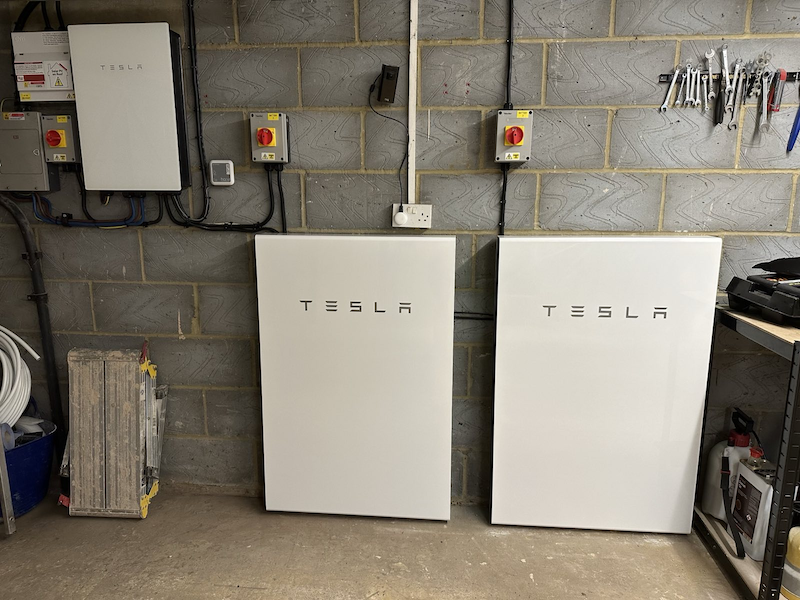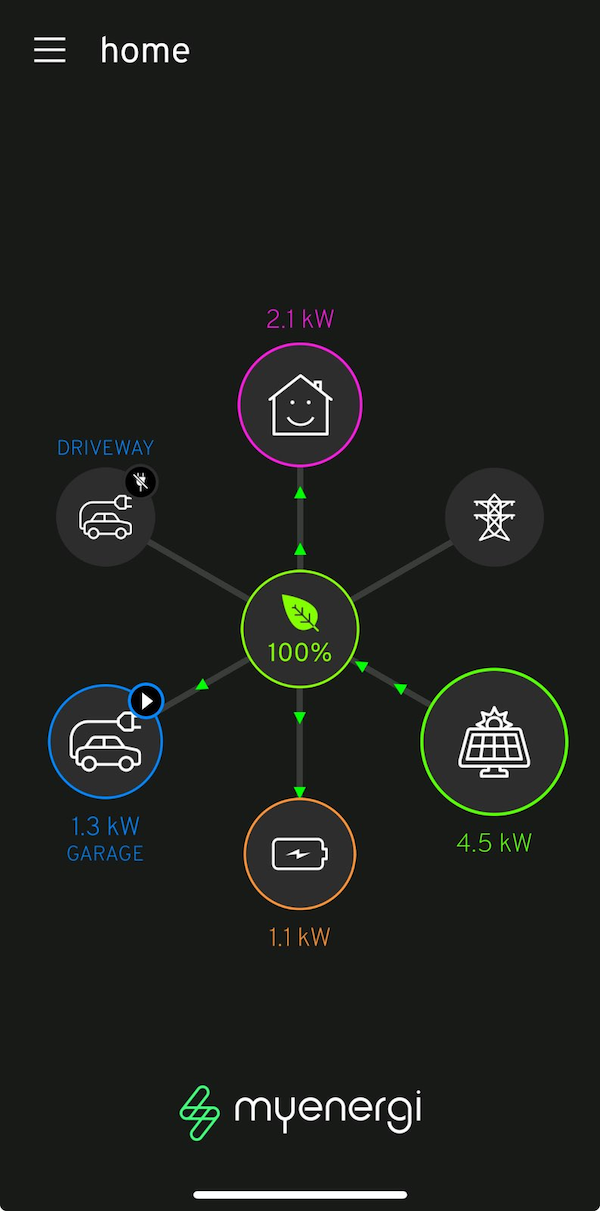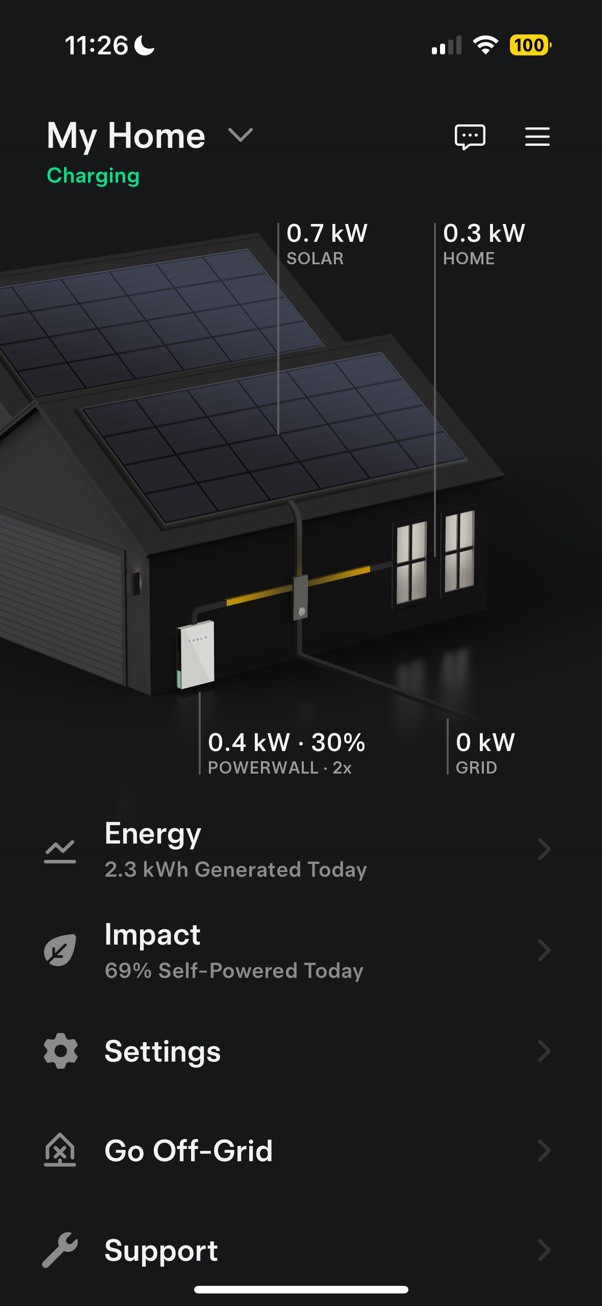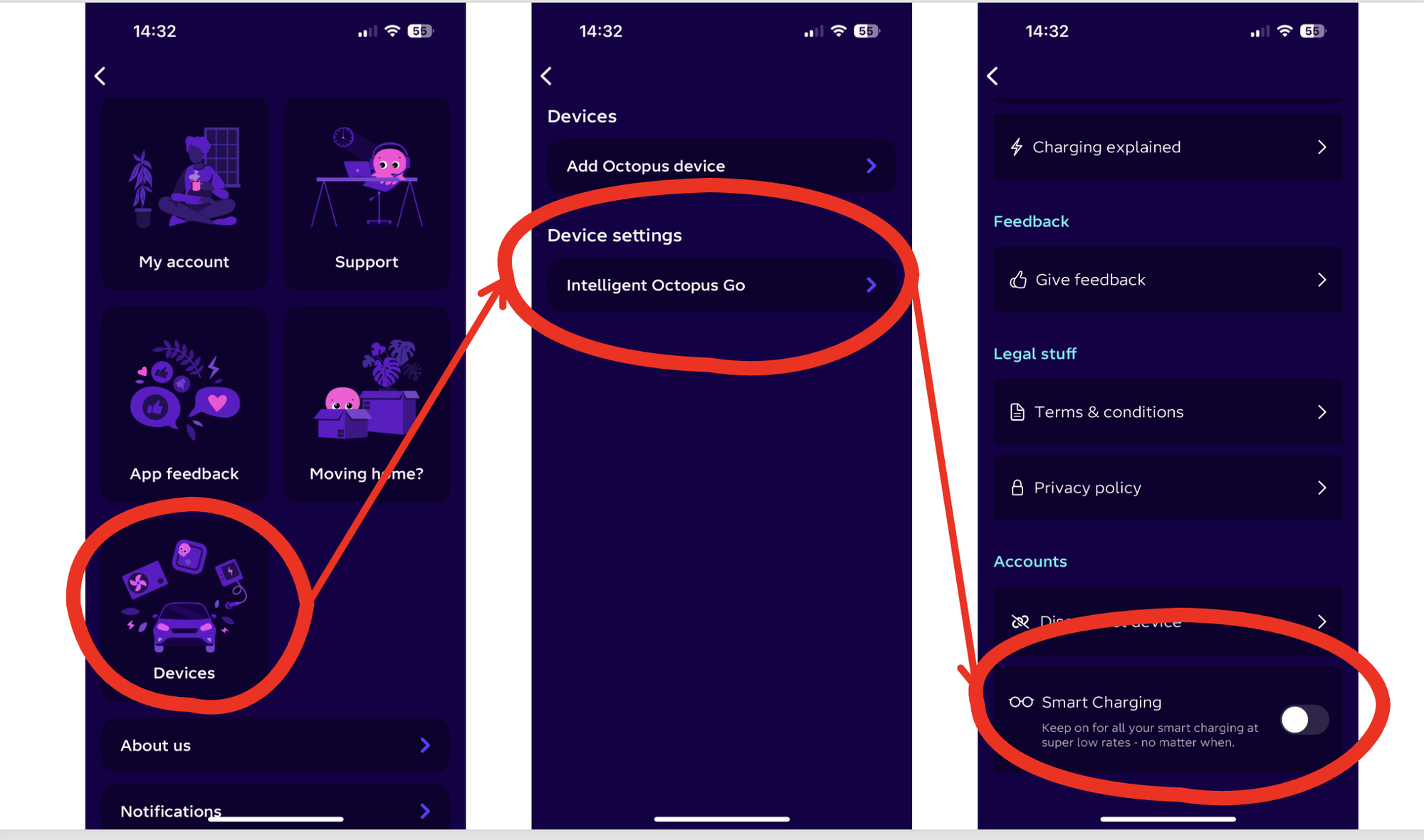Towards Complete Domestic Electrification
Adding Tesla Powerwalls, Zappi smart EV chargers, and switching wholly to electric vehicles.
It has been a long time since I wrote about my experiences in electric vehicles and home charging, and much has changed in my home since then with the addition of more EVs, chargers, solar panels (thermal and PV), and storage (heat and battery).
I’ll deal with the renewable heat side of things in another post (since that is an ongoing work). In this post I’m going to talk about my experience of installing and using batteries, smart chargers, and time-of-use electricity tariffs. Specifically:
Back in 2020 when I wrote about installing my first smart charger, my situation was pretty straightforward, though not very optimised. I owned (and still own) a BMW i3 which can be charged using excess solar via the Zappi charger as well as power drawn from the grid. The downsides of this setup are that the i3 has a small battery (~20kWh) and sometimes the car is elsewhere which both limit my capacity for absorbing excess solar. So often when the sun is bright, power is “lost” to grid.
To be plain, I like the grid. The grid is a public good, and my excess generation displaces otherwise more polluting ways of producing power. What I am less fond of is the lack of net metering which means I buy power at roughly 4x more than I sell it, which feels like a bit of a rip off.
Replacing our Combustion Engine Car with a Second EV
Though we owned an electric vehicle (BMW i3) which was our daily workhorse, we also retained our elderly Toyota Prius for long journeys. We had thought that eventually the next stage of the process would be to buy an EV with a large battery to replace the Prius eventually, but those of you living in the UK will recall that in 2021 the nation ran out of petrol. There were queues for fuel all round the country and that triggered us to replace our Prius with a Tesla Model 3 on the basis that we can make our own electricity, but not our own petrol!
For the avoidance of smugness, even though we no longer needed to queue for petrol, we still got caught in all the madness because the queues for the petrol stations were so long that they congested all the roads anyway! Such is life.
With two EVs we needed to charge them both conveniently. I added a Zappi charger in the driveway to complement the existing one in the garage. The two chargers are paired wirelessly, and they share solar generation and grid use so that any excess power can be siphoned to either of the vehicles (and respect grid import limits too). From the point of view of using local generation, this is much better than with a single car, since there’s often at least one car plugged in (cars spend a lot of their time parked at home!). In addition, the Model 3 has a ~75kWh battery its can soak up several days’ worth of excess solar if left connected.
But then geopolitics happened. With the Russian invasion of Ukraine, methane (so-called natural gas) prices skyrocketed. Since the previous UK government took the unwise intellectual shortcut of pricing electricity as a function of gas, the price of electricity in the UK also skyrocketed (300% in my case). This is particularly egregious since the grid in Great Britain is increasingly less reliant on gas and more on renewables. Although 50.9% of UK electricity was from renewables in the first quarter of 2024, a kilowatt-hour of electricity for domestic use tripled in price with the onset of war, and has roughly remained at that level to-date.
Installing Tesla Powerwall 2 Units
Even with solar generation my electricity bill is stratospheric, so this year I did the sums and decided to do something about it. My approach was twofold, to install batteries and move to a time of use tariff so that I could significantly lower my electricity bill. I chose the Intelligent Octopus Go tariff which currently provides 6 hours of electricity between 11:30pm and 5:30am at £0.07 and £0.24 otherwise. Since we use around 1MWh per month for home and cars, and I get around 5MWh from solar generation annually, I could potenally buy 7MWh anually at off-peak prices by time-shifting with batteries. This is an annual saving of around £1200 some of which I reasoned could be used to by the necessary battery infrastructure.
Note: the unit cost of electricity figures apply at time of writing (and were slightly higher at £0.075 and £0.28 when I first installed the system), but volatility in the energy markets and change of seasons will change the absolute numbers. The point remains, however: off-peak electricity is very cheap now and will be for the forseeable future.
I chose the Tesla Powerwall 2 for my battery needs and have installed two units with 26kWh of usable power. The arithmetic is pretty simple: the Powerwall units should last for 20+ years (guaranteed for only 10 however) and at a fully installed cost of just shy of £13,000 they will pay for themselves in under 11 years, leaving 9+ years as “profit.” This isn’t something I could fund out of my pocket, but fortunately the Nationwide Building Society currently offer 0% loans to their mortgage customers to retrofit their homes with energy improvements. Win!
Note: I intend to add a third Powerwall 2 to the system shortly up to the maximum permitted capacity of three units on a single phase (my house has a single phase 100A supply). This will support time-shifted energy needs of a heat pump to be installed in the future.
The choice of a Powerwall 2 was deliberate. While Powerwall 3 had come to the market in my purchasing window, I won’t benefit from its integrated inverter (despite the lower energy losses of DC-DC storage). All my solar panels have microinverters, and so there is no high voltage DC in my system, just line voltage AC (230v). As such, AC coupled batteries are fine for me. They also have a good physical footprint, lying flat along the garage wall.

I chose Spirit Energy to perform the installation. They were cost-effective and felt to me like they knew what they were doing, with both the Tesla system and the existing MyEnergi equipment. The installation took two days, not so much because of the batteries themselves which were installed very quickly, but because of some remedial wiring work to move my two EV chargers from the regular house circuits (which the Powerwalls will keep live even in the event of a power cut) to non-backed up circuits. This means the cars won’t charge in a powercut, but the house will keep running a lot longer because of it.
Everything went pretty well with the installation. Various additional current clamps were mounted and wired into their respective systems (both the Tesla and the MyEnergi kit). The Tesla equipment came online seamlessly and took stock of the situation straight away. The MyEnergi kit was more fiddly - the in-house equipment acknowledged the presence of an AC battery, but it would not appear on the MyEnergi app as it should. It took a factory reset of all the MyEnergi equipment to solve that issue. Annoying, but I’ve done it a lot over the last few months (after a recent firmware upgrade noticably reduced stability) so at least now it’s a 10 minute job rather than an hour of scrolling through LCD scren menus.
Now both Tesla and MyEnergi apps work, and I get slightly different views of current and historical data from each. The MyEnergi app is better at telling me about EV charging (which Tesla thinks is the house drawing lots of power), whereas the Tesla app is good at battery charging (while MyEnergi does not store historical data for 3rd party batteries).
Changing to Intelligent Octopus Go and Smart Meters
At this point, I was all set to change my grid connection too. After having my old analogue meters swapped out for smart meters (reluctantly, I have to say, because of lingering dependability concerns), and waiting a couple of days for the computers to catch up, I was able to sign up for a variable rate tariff.
To sign up for the Intelligent Octopus Go tariff, you have to hand over some control of your equipment to Octopus. You can cede control of a car, home battery, or car charger socket and while Octopus retain access to that equipment, you stay on the tariff. This currently gives you 6 hours of off peak charging every night, plus whenever electricity is abundant (which usually means windy here in the UK) they’ll give you off peak prices then aswell, and turn on your equipment to make use of it. But here’s where I learned that being close to the bleeding edge needs a bit of patience.
Using the Octopus app, I tried to grant Octopus permission to control my Zappi chargers. This repeatedly failed. I gave up, and tried to grant permission to my Model 3 instead which also failed, from Octopus’s side but not from Tesla’s (how I hate partial failures). I didn’t try integrating with the Powerwalls because I felt I was already in a mess.
With low expectations, I called Octopus support. I explained my situation and the support staff responded that they hadn’t encountered this before, but that if I would hold, then they’d find out more. My expectations remained low. A few minutes later, they came back to me and told me the problem: they don’t support more than one Zappi charger per property but if I temporarily deleted one of the chargers from my MyEnergi account then it would all work, and they said they’d email me instructions.
This isn’t a solution for everyone, but I was game. The email arrived moments later and off I went deleting records from my MyEnergi account. On the next attempt I was able to grant permissions for Octopus to control my “only” Zappi charger and soon after my Octopus app told me that I had transferred to the new tariff. Kudos to the Octopus support folks!
Then it was a matter of reinstating my other charger into my system. Octopus told me they wouldn’t be able to do smart things with that charger, but it would still benefit from it being cheap to run during the night time and still take advantage of excess solar. This is fine with me. I reinstated the charger, but the MyEnergi app displayed nonsense readings again. Another factory reset and reconfiguration of chargers, harvis, and hub and the app worked again (at least for displaying data though it has been flakey for switching between charging modes lately).

Finally I configured the Powerwalls to understand time of use tariffs, and ensured that the Zappi chargers were switched to Eco+ mode (to consume any excess solar) with a boost window that matches the cheap time of use. The result is that the Powerwall batteries charge with excess solar below 1.4kW while above that any connected cars take precedence. At night time cars and batteries can charge cheaply if they need to.
A Learning Curve
This all takes a bit of getting used to, and is definitely not plug and play. To get the most out of the system I’m finding that I have to pay close attention. If I see the battery about to saturate from solar, I plug in a car if I can. If we have consecutive grey days, I might allow overnight charging from the grid, unless tomorrow might be sunny then I take a punt.
I think this will be easier in winter when there is very little solar generation to manage, but I’m moving towards the general rule that, in summer, the batteries should not charge from the grid, and cars should only be plugged in at night or when there has been quite a lot of solar.

I find I also have to watch out for grid consumption by the Powerwall units. If given permission, my Powerwalls definitely overcharge themselves when power is cheap overnight leaving little room for solar gain on the next fine summer day. This might be OK if there is capacity in a car battery, but often the cars have charged themselves overnight too! This means I either divert to hot water via an immersion heater (meaning I don’t burn any gas) or to the grid (which is public spirited but reduces economic efficiency for me). It’d be nice if Tesla could automate this better using predicted solar gain based on historical generation and usage.
With respect to the to Intelligent Octopus Go, it is pretty good in principle, but in practice I’ve found I like it best as a “dumb” time-of-day tariff with all the smart things happening within my control. The smart aspect where it will turn on a car charger when the unit price of electricity drops is actually bad for me. Why? Because when the charger is activated during peak hours because of cheap grid prices, in my setup the power comes from the Powerwalls which know nothing about that cheap spot pricing. Instead they do what they think is the right thing and try to prevent grid use by discharging the required load (up to 10kW isn’t a problem for two units). The likely outcome is that the Powerwalls become depleted by a fast car charge and once the cheap unit price ends, I then have to pay peak tariff from the grid.
What’s Next?
Part of me thinks that I’d just like to delegate all of my equipment to Octopus so they can manage it in return for cheap power at point of use. Maybe that will happen as domestic renewables become better at integrating rather than just relying on current clamps! Or the other way if I could just have predictability from grid pricing, then I can do smart things on my side.
In the absence of richer integrations, my next steps are to learn better how to get the best out of this system as the seasons change. I expect it to behave much more predictably when solar generation is low (as it is in winter).
We’re not yet fully electrified at home, though the move to smart meters has prompted me to look more into the large amount of energy we consume at home for heating and hot water. When I get chance I’ll write up some of the steps we’ve taken to use reduce demand and partially fulfill it through on-site renewables. Hopefully it’ll be less than a the four year gap it took between this piece and the previous!
Update (2024-09-01)
A couple of things have happened since I oringally wrote this post. One is that I left my Powerwalls alone for over two weeks while I went on holiday. I switched it to run the house solely on solar (no grid imports), and apart from that I let it be. Having returned from holiday, something clever has happened whereby the Powerwalls are now much better at predicting how much off-peak electricity they should import over night, seemingly based on how much power they think might be generated by the solar panels. This isn’t 100% accurate, but it is a lot better than me having to think about it.
The other is an error/omission of my own. I mentioned that under the Octopus energy scheme, one of my Zappi chargers would potentially switch on during a period of cheap grid electrcity and discharge my home batteries into my car (since the home batteries don’t know any better and dutifully discharge when asked). I latterly found out this can be disabled, in the Octopus app as you can see here:

In practice now my EV chargers will charge the cars only when there is excess solar (not so much as we head into Autumn) or overnight when the cost of grid power is cheap.